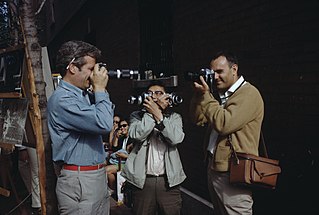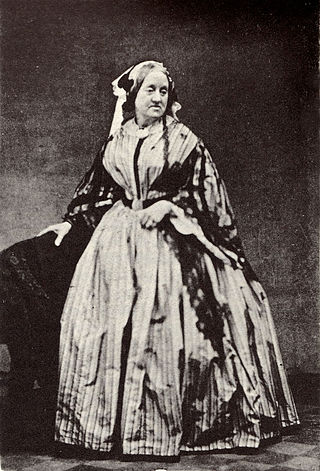
Photography is the art, application, and practice of creating images by recording light, either electronically by means of an image sensor, or chemically by means of a light-sensitive material such as photographic film. It is employed in many fields of science, manufacturing, and business, as well as its more direct uses for art, film and video production, recreational purposes, hobby, and mass communication.

The cyanotype is a slow-reacting, economical photographic printing formulation sensitive to a limited near ultraviolet and blue light spectrum, the range 300 nm to 400 nm known as UVA radiation. It produces a cyan-blue print used for art as monochrome imagery applicable on a range of supports, and for reprography in the form of blueprints. For any purpose, the process usually uses two chemicals: ferric ammonium citrate or ferric ammonium oxalate, and potassium ferricyanide, and only water to develop and fix. Announced in 1842, it is still in use.
Xerox art is an art form that began in the 1960s. Prints are created by putting objects on the glass, or platen, of a copying machine and by pressing "start" to produce an image. If the object is not flat, or the cover does not totally cover the object, or the object is moved, the resulting image is distorted in some way. The curvature of the object, the amount of light that reaches the image surface, and the distance of the cover from the glass, all affect the final image. Often, with proper manipulation, rather ghostly images can be made. Basic techniques include: Direct Imaging, the copying of items placed on the platen ; Still Life Collage, a variation of direct imaging with items placed on the platen in a collage format focused on what is in the foreground/background; Overprinting, the technique of constructing layers of information, one over the previous, by printing onto the same sheet of paper more than once; Copy Overlay, a technique of working with or interfering in the color separation mechanism of a color copier; Colorizing, vary color density and hue by adjusting the exposure and color balance controls; Degeneration is a copy of a copy degrading the image as successive copies are made; Copy Motion, the creation of effects by moving an item or image on the platen during the scanning process. Each machine also creates different effects.

Color photography is photography that uses media capable of capturing and reproducing colors. By contrast, black-and-white or gray-monochrome photography records only a single channel of luminance (brightness) and uses media capable only of showing shades of gray.
William Eggleston is an American photographer. He is widely credited with increasing recognition for color photography as a legitimate artistic medium. Eggleston's books include William Eggleston's Guide (1976) and The Democratic Forest (1989).

A photo booth is a vending machine or modern kiosk that contains an automated, usually coin-operated, camera and film processor. Today, the vast majority of photo booths are digital.

A toy camera is a simple, inexpensive film camera.

Fine-art photography is photography created in line with the vision of the photographer as artist, using photography as a medium for creative expression. The goal of fine-art photography is to express an idea, a message, or an emotion. This stands in contrast to representational photography, such as photojournalism, which provides a documentary visual account of specific subjects and events, literally representing objective reality rather than the subjective intent of the photographer; and commercial photography, the primary focus of which is to advertise products, or services.
The paper negative process consists of using a negative printed on paper to create the final print of a photograph, as opposed to using a modern negative on a film base of cellulose acetate. The plastic acetate negative enables the printing of a very sharp image intended to be as close a representation of the actual subject as is possible. By using a negative based on paper instead, there is the possibility of creating a more ethereal image, simply by using a type of paper with a very visible grain, or by drawing on the paper or distressing it in some way.

Anna Atkins was an English botanist and photographer. She is often considered the first person to publish a book illustrated with photographic images. Some sources say that she was the first woman to create a photograph.
A chromogenic print, also known as a C-print or C-type print, a silver halide print, or a dye coupler print, is a photographic print made from a color negative, transparency or digital image, and developed using a chromogenic process. They are composed of three layers of gelatin, each containing an emulsion of silver halide, which is used as a light-sensitive material, and a different dye coupler of subtractive color which together, when developed, form a full-color image.

William Klein was an American-born French photographer and filmmaker noted for his ironic approach to both media and his extensive use of unusual photographic techniques in the context of photojournalism and fashion photography. He was ranked 25th on Professional Photographer's list of 100 most influential photographers.

Helmut Erich Robert Kuno Gernsheim was a historian of photography, a collector and a photographer.
The LGBT community in London is one of the largest within Europe. LGBT culture of London, England, is centred on Old Compton Street in Soho. There are also LGBT pubs and restaurants across London in Haggerston, Dalston and Vauxhall.

William Jay was a photographer, writer on and advocate of photography, curator, magazine and picture editor, lecturer, public speaker and mentor. He was the first editor of "the immensely influential magazine" Creative Camera (1968–1969); and founder and editor of Album (1970–1971). He is the author of more than 20 books on the history and criticism of photography, and roughly 400 essays, lectures and articles. His own photographs have been widely published, including a solo exhibition at the San Francisco Museum of Modern Art. He is known for his portrait photographs of photographers.
Jill Freedman was an American documentary photographer and street photographer. She was based in New York City.

Modern Photography was a popular American photo magazine published and internationally distributed for 52 years from New York City. An unrelated Modern Photography magazine was published in Taiwan from 1976.
Shari Diamond is a queer American feminist artist and educator. Diamond uses they/them gender pronouns. Diamond was born in Miami Beach, Florida and earned an M.A. in Photography from New York University / International Center of Photography. They currently live in Newburgh, New York.
Mark Eshbaugh is an American artist, author, educator, and musician. He has specialized in alternative photography processes such as platinum/palladium and chrysotype printing, and gum bichromate, cyanotype and Mordançage processing. He holds a BFA degree from the University of Massachusetts Lowell and an MFA degree from the Savannah College of Art and Design.










